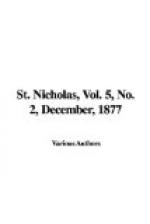Readers who were interested in Professor Proctor’s letter about the Sea-Serpent in ST. NICHOLAS for August last, may like to read also these little extracts on the same subject:
From the New York “Independent."
A sea-monster was seen by the officers of H.M.S. “Osborne,” on June 2, off the coast of Sicily, which is sketched by Lieut. Haynes and figured in the London Graphic. The first sketch is merely of a long row of fins just appearing above the water, of irregular height, and extending, says Lieutenant Osborne, from thirty to forty feet in length. The other sketch is of the creature as seen “end on,” and shows only the head, which was “bullet-shaped and quite six feet thick,” and a couple of flappers, one on each side. The creature was, says Lieutenant Osborne, at least fifteen or twenty feet wide across the back, and “from the top of the head to the part of the back where it became immersed I should consider about fifty feet, and that seemed about a third of its whole length.” Thus it is certainly much longer than any fish hitherto known to the zooelogists, and is, at least, as remarkable a creature as most of the old wonder-makers ever alleged.
From the “National Teachers’ Monthly,” September.
Mr. John Kieller Webster says he has seen the sea-serpent in the Straits of Malacca. Its body was fifty feet in length, the head twelve feet, and the tail one hundred and fifty. It seemed to be a huge salamander. The Chinese on board the ship were so frightened, they set up a howl,—a circumstance very remarkable.
* * * * *
THE GAME OF FAGOT-GATHERING.
There is a jolly in-door game, for the winter, called “Fagot-Gathering,” which has been described in print before, but it makes so much fun that many who have never heard of it will be glad if we tell about it here.
First you take some slips of paper,—as many as there are players,—and on one of them you write “Fagot-Gatherer;” on each of the rest you write either “good wood” or “snapper,” making three times as many “good woods” as “snappers.” Of course, anybody who knows about wood-fires will see that this is because some sticks will burn quietly and brightly while others will crack and snap and fly without the least warning. You put the papers into a hat, and each player takes one, telling nobody what is written on it. Every one then sits as near to the wall as possible, leaving a clear space in the middle of the room, and the player who has chosen the “Fagot-Gatherer” slip proceeds in a serious, business-like way to bundle the fagots. He, or she, chooses four or five girls and boys, standing them together to represent a fagot, and then makes similar groups of the rest in other parts of the room. This done, he begins to “bind the fagots” by walking slowly around each group, making with his arms such motions as a real fagot-binder would make.




